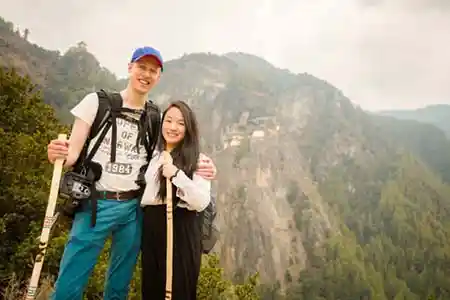Package Description
5N/6D Paro, Thimphu, and Punakha collectively form the golden triangle of Bhutan, offering a mesmerizing journey through the heart of this enchanting Himalayan kingdom. As you embark on the Paro Thimphu Punakha tour, you are not merely traversing geographical distances but stepping into a realm where tradition seamlessly intertwines with modernity, and the serene beauty of nature harmonizes with the spiritual essence of Bhutan. The journey typically begins in Paro, the gateway to Bhutan, where the sole international airport of the country is nestled in a valley surrounded by lush green hills. The Paro Valley is not only scenically breathtaking but also holds deep historical and cultural significance. Dominated by the iconic Paro Taktsang, or Tiger's Nest Monastery, precariously perched on a cliff, this sacred site is a testament to the profound Buddhist heritage that pervades Bhutan. As you explore Paro, the town's streets lined with traditional Bhutanese architecture provide a glimpse into the local way of life. The National Museum of Bhutan, housed in a historic watchtower, unfolds the rich tapestry of Bhutanese history and art. The Kyichu Lhakhang, one of the oldest temples in Bhutan, invites contemplation with its serene surroundings and ancient ambiance. The traditional markets of Paro offer an opportunity to engage with the vibrant local culture, where handicrafts, textiles, and Bhutanese delicacies showcase the country's artistic prowess. Leaving Paro, the journey takes you to Thimphu, the capital city of Bhutan. Despite being a capital, Thimphu retains its unique charm as one of the world's smallest and least developed capital cities. The juxtaposition of traditional dzongs (fortresses) and modern structures symbolizes Bhutan's commitment to preserving its cultural heritage while embracing progress. The Tashichho Dzong, an impressive fortress with ornate architecture, serves as the seat of the Bhutanese government and the King's official residence. Visiting the Buddha Dordenma, a gigantic statue overlooking the valley offers panoramic views and a serene atmosphere for reflection. Thimphu's streets are alive with the vibrancy of local markets, where indigenous products, hand-woven textiles, and intricately crafted souvenirs are showcased. The Folk Heritage Museum provides insight into the rural life of Bhutan, allowing visitors to step into a traditional farmhouse and experience the simplicity and authenticity of the Bhutanese lifestyle. The National Institute for Zorig Chusum, also known as the Painting School, preserves and promotes Bhutanese arts and crafts, ensuring the continuation of traditional skills. One of the highlights of the Paro Thimphu Punakha tour is the journey over the Dochula Pass, which connects Thimphu to Punakha. This mountain pass, adorned with 108 stupas and offering breathtaking views of the snow-capped Himalayas, is a spiritual and visual feast. It marks a transition from the capital to the ancient capital, Punakha, and signifies a shift in landscapes from the cool mountain air to the warmer valleys. Punakha, nestled at a lower altitude, welcomes visitors with its subtropical climate and lush vegetation. The Punakha Dzong, strategically located at the confluence of the Pho Chhu and Mo Chhu rivers, is an architectural marvel and holds immense historical importance. The dzong played a crucial role in Bhutanese history as the site of the coronation of the first king and continues to be a central hub for religious and administrative activities. The Chimi Lhakhang, or the Temple of the Divine Madman, adds a touch of whimsy to the tour with its phallic symbols and unique rituals believed to bless couples with fertility. The fertility temple, surrounded by mustard fields and rice paddies, reflects the harmonious blend of Bhutanese spirituality and cultural idiosyncrasies. Beyond the cultural treasures, the Punakha Valley itself is a spectacle of natural beauty. The terraced fields, traditional farmhouses, and meandering rivers create a picturesque backdrop that complements the tranquility of the region. A leisurely walk through the rural villages allows you to witness the daily lives of the Bhutanese people, their agricultural practices, and their deep connection to the land. The Paro Thimphu Punakha tour is not just a physical journey through these three distinctive locations; it is a spiritual and cultural odyssey. The Bhutanese concept of Gross National Happiness (GNH) becomes tangible as you interact with the warm and friendly locals, savor the unique flavors of Bhutanese cuisine, and immerse yourself in the sacred ambiance of monasteries and dzongs. The tour provides ample opportunities for trekking enthusiasts, with trails ranging from the relatively easy hike to the Taktsang Monastery to more challenging routes through pristine forests and alpine meadows. These treks not only offer breathtaking views but also allow for a deeper connection with Bhutan's unspoiled natural landscapes.
In conclusion, the Paro Thimphu Punakha tour is a transformative journey that transcends the conventional travel experience. It is an exploration of Bhutan's cultural treasures, a communion with its pristine nature, and a contemplation of the timeless wisdom embedded in its spiritual heritage. Whether you are captivated by the ancient mystique of Paro, enchanted by the quaint charm of Thimphu, or entranced by the timeless beauty of Punakha, this tour is an invitation to discover 5N/6D Paro, Thimphu, and Punakha tour, where happiness is not just a destination but an intrinsic way of life.
 6D /
5N
6D /
5N